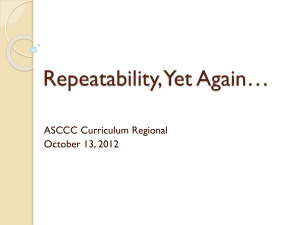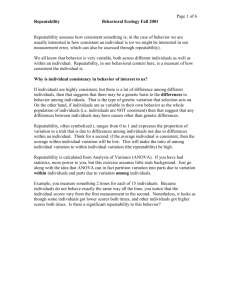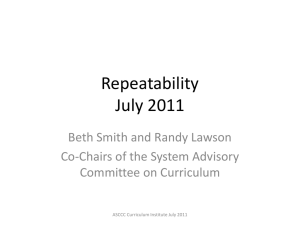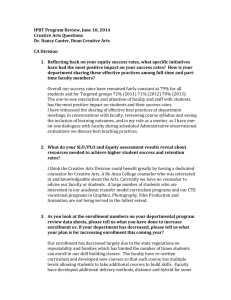Appendix C: Recommendations Regarding Repeatability
advertisement
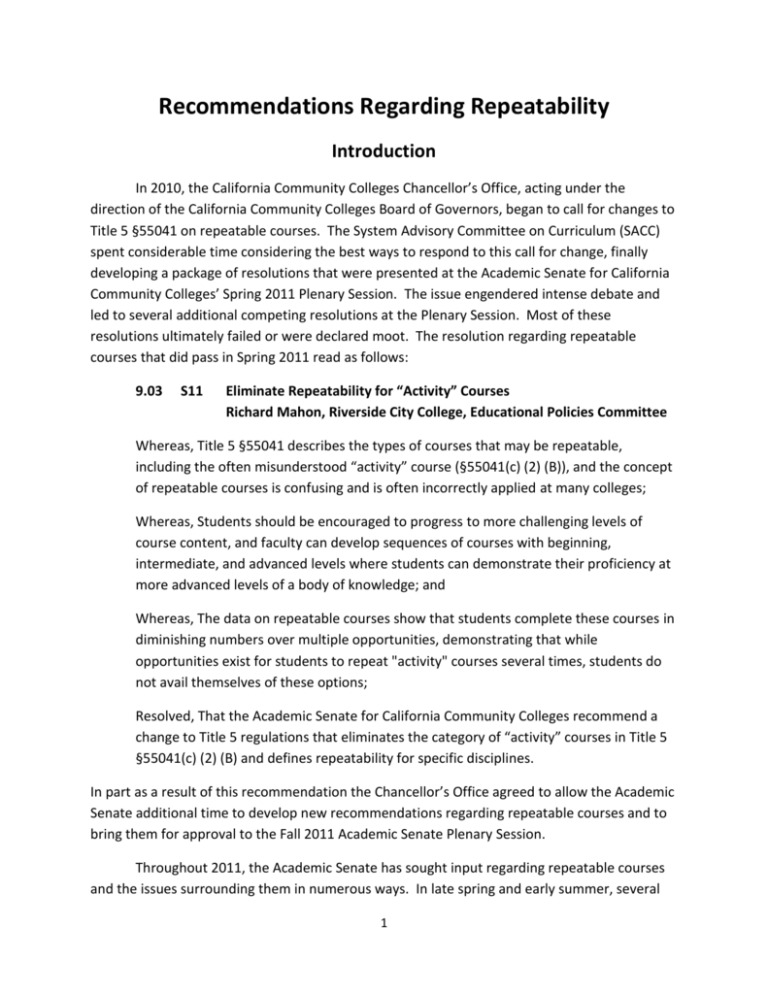
Recommendations Regarding Repeatability Introduction In 2010, the California Community Colleges Chancellor’s Office, acting under the direction of the California Community Colleges Board of Governors, began to call for changes to Title 5 §55041 on repeatable courses. The System Advisory Committee on Curriculum (SACC) spent considerable time considering the best ways to respond to this call for change, finally developing a package of resolutions that were presented at the Academic Senate for California Community Colleges’ Spring 2011 Plenary Session. The issue engendered intense debate and led to several additional competing resolutions at the Plenary Session. Most of these resolutions ultimately failed or were declared moot. The resolution regarding repeatable courses that did pass in Spring 2011 read as follows: 9.03 S11 Eliminate Repeatability for “Activity” Courses Richard Mahon, Riverside City College, Educational Policies Committee Whereas, Title 5 §55041 describes the types of courses that may be repeatable, including the often misunderstood “activity” course (§55041(c) (2) (B)), and the concept of repeatable courses is confusing and is often incorrectly applied at many colleges; Whereas, Students should be encouraged to progress to more challenging levels of course content, and faculty can develop sequences of courses with beginning, intermediate, and advanced levels where students can demonstrate their proficiency at more advanced levels of a body of knowledge; and Whereas, The data on repeatable courses show that students complete these courses in diminishing numbers over multiple opportunities, demonstrating that while opportunities exist for students to repeat "activity" courses several times, students do not avail themselves of these options; Resolved, That the Academic Senate for California Community Colleges recommend a change to Title 5 regulations that eliminates the category of “activity” courses in Title 5 §55041(c) (2) (B) and defines repeatability for specific disciplines. In part as a result of this recommendation the Chancellor’s Office agreed to allow the Academic Senate additional time to develop new recommendations regarding repeatable courses and to bring them for approval to the Fall 2011 Academic Senate Plenary Session. Throughout 2011, the Academic Senate has sought input regarding repeatable courses and the issues surrounding them in numerous ways. In late spring and early summer, several 1 conference calls with faculty who teach in the disciplines that most often make use of repeatable courses helped to provide information regarding student needs being served by repeatability. A general session and breakout at the ASCCC Curriculum Institute in July 2011 featured further dialogue on these issues. In September, regional curriculum meetings held at Foothill College and Mount San Antonio College explored curricular alternatives that might be viable methods of meeting the needs previously served by repeatability. In addition to these public methods of gathering information, the Academic Senate also received direct input in the form of position statements and letters from various interested groups. In conversations with discipline faculty, issues regarding the value of college credit and the meaning of a "C" grade also emerged. Many courses have been deemed worthy of college credit by curriculum committees for the FTES they generate, yet concerns exist about the rigor of the courses, the necessity of actually awarding valuable college credit for such participation, and whether students need a transcript indicating grades and credit for the courses. Repeatability allows students who have passed a course (grade of C or higher, Credit or Pass) to retake the course. Faculty have used repeatability to allow students who have not quite met proficiency or all the objectives of a course to earn a "C" for the first attempt and then return to repeat the course where the student might improve his or her grade and attain all necessary outcomes for the course. Questions arose about this practice because there is no guarantee that a student will return to repeat a course for which the student has earned a passing grade, and thus the student will have college credit for having achieved outcomes that he or she may not in fact have achieved. Furthermore, the argument that students who earn a “C” grade could benefit from more instruction and practice could apply to any course in the college curriculum, especially basic skills courses, yet those courses are specifically prohibited from use of repeatability. At the same time, the Academic Senate continues to be mindful of the ongoing directive from the Chancellor’s Office that our efforts in all areas, including this discussion, should be focused on students who are seeking specific academic goals. In the past, repeatability has been used to serve the needs of lifelong learning and service to the community in many areas. The Chancellor’s Office has reminded us repeatedly that in the current economic climate we cannot continue to serve these purposes in the ways or to the degree that we have in the past. All of the information from these various sources was considered by a Repeatability Task Force organized jointly by the Academic Senate and the Chancellor’s Office. The task force included the past and current ASCCC Curriculum Committee Chairs, faculty representatives from the disciplines that would be most impacted by changes to repeatability, representatives for both administration and articulation, and Chancellor’s Office staff. 2 After three intense meetings that included broad and lively discussion, the Repeatability Task Force arrived at the recommendations contained in this document. These recommendations represent the task force’s best effort to find alternatives to repeatability wherever possible in order to make more viable the defense of those areas in which no alternatives were found. The intent of the Academic Senate is to find curricular solutions to repeatability in order to maintain consistency and ease of understanding of any restrictions placed on a discipline. One of the more controversial aspects of the task force recommendations may be the limits suggested for both performance ensemble classes and for physical education courses as a whole. These limits were included to address a fear that without them the task force might be accused of having made no substantive change in those areas. Without the limits, students could continue to enroll in ensemble performance classes and to have those enrollments subsidized by state funding without end. Regarding physical education, members of the task force felt that new levels and more specifically focused courses could be proliferated almost endlessly, thus effectively allowing students to continue their enrollment in such classes indefinitely. While the task force did not reach unanimous agreement on the need for such limits or on the specifics of those limits, the majority decisions are reflected in the recommendations as a best attempt at both responding to the input of discipline faculty and demonstrating a meaningful contraction of repeatability in the areas that have prompted the most intense scrutiny. The final decision as to whether these recommendations should represent the will of the Academic Senate in the revision of Title 5 §55041 on repeatable courses will be made by the delegates at the Fall 2011 Plenary Session. However, the delegates should be cognizant of the fact that no further time extension on this issue will be forthcoming from the Chancellor’s Office. If a position that is acceptable both to the faculty and to the Chancellor’s Office and Board of Governors cannot be identified at the Fall 2011 Plenary Session, then the Academic Senate will have no formal position to guide the Title 5 revision, leaving the revision—which will happen in any case—largely in the hands of non-faculty. The Repeatability Task Force thanks you for your time in reading and your consideration of these recommendations. 3 Task Force Recommendations The primary recommendation is to eliminate repeatable courses except under certain limited circumstances as outlined below. Visual and Performing Arts With reductions to arts budgets and minimal exposure to the arts in K-12, community college students find a wealth of opportunity to initiate study and to appreciate the arts at the colleges. Students without experience with the arts as possible majors or careers need time to test and try various types of studio art as well as performing arts. Through their exposure, students discover latent talent and develop existing skills through community college programs, leading some to choose one of the visual or performing arts disciplines as a major. In order to become an art, dance, theater, or music major or to find a job in these areas directly from the community college, students need practice time as individuals, practice with groups or ensembles, and exposure to many genres or areas within a production or studio. Students need opportunities to study art and discern which art medium conveys each student’s voice or to learn to play an instrument with a group, to grow to be the lead (or chair), or sing solos or with a choir. And because many students had limited access to arts programs during elementary, middle or high school, some students need more time to progress to a level of competency required for admission into upper division work or to secure a job. The development time for these disciplines may be from two to four years at the community college level. Since most community college students attend a college for more than two years for many valid reasons, programs of study for visual and performing arts majors should be planned for students to develop in a minimum of two years and reach proficiency at a competitive level soon after that. Some students may take longer to develop the necessary skills, and private lessons may be required to help some students achieve the performance level desired. During the course of study, students will take general education courses along with courses for the major, including one or two performance courses each semester. People within the community grow to appreciate the arts through the students and their productions or projects, which improves the culture beyond the boundary of the college. Performing arts programs are often dependent on participation of community members who complete the ensembles for the traditional music or theater students. With productions presented throughout the school year, and often in the summer, communities depend on entertainment and events that increase goodwill between the colleges and their patrons. 4 Recommendations: Continue repeatability for ensemble performance courses in music, theater and dance. Ensemble courses allowing repeatability will not be broken into separate levels. Leveled courses will not be eligible for repeatability. Limit students to repeating a specific performance course a maximum of 3 times and to a total of 16 units of performance courses total per college. Address community or extended participation needs through non-credit, audit, and community service classes by requesting appropriate changes to Ed Code. Eliminate repeatability for all other visual and performing classes, including all classes in studio art and all non-performance classes in music, theater, and dance. Purposes currently served by repeatability in these areas can be accomplished through existing curricular options. Career Technical Education Students studying vocational programs must meet degree requirements as well as licensing and other requirements established by the field. The goal of these programs is to provide enough time on task to become proficient with certain skills, especially hands-on application of the knowledge and information provided through instruction. When faculty can establish the acceptable level of proficiency required and the number of hours the college should expect a student to need to achieve that level, then a course can be designed to meet those goals. In all cases, students need access to equipment and facilities and must be supervised while working in labs and other specially outfitted classrooms and while using equipment or other resources pertinent to the course content. Whether students are learning to weld, perform smog checks, mix hair dye, or do court reporting at proficient speeds, all these tasks can be accomplished through curriculum structures that already exist. Both credit and noncredit curriculum can be developed to meet the needs of these students. Recommendations: Eliminate repeatability for CTE classes. Purposes currently served by repeatability in this area can be accomplished through existing curricular options. Allow students to petition to repeat courses or use other existing curricular structures for purposes of fulfilling licensure requirements. Student need for retraining of job skills can be accommodated through lapse of time policies. Physical Education 5 Students have enjoyed PE courses for years. The variety of sports and easy access to quality instruction have made these courses especially desirable to transfer students as well as students of life-long learning from the community. Well designed PE courses provide a core of instruction that teaches students about heart rates, nutrition, safety, and overall wellness in addition to time on the court, in the pool, or on fitness equipment. With the nation’s interest in health beginning to rise due to recent reports on obesity, disease, and injury prevention, community colleges cannot overlook their responsibilities to educate students about behaviors and choices that may increase their chances for healthier, more productive lives. Like visual and performing arts, K-12 once did the job of educating students about health, exercise, disease prevention, and wellness. With a reduced PE curriculum in elementary, middle, and high school, community colleges once again find themselves giving instruction that should already have been provided to citizens by age 18. In addition, students who have a good experience with PE in school often look to continue playing sports or engaging in organized wellness activities through PE courses in college. Recommendations: Separate intercollegiate athletics from PE as much as possible. Use the separate TOP codes for the courses aimed at dance, PE, health, and athletics. Disciplines can continue to exist in any local division/department structure even when the courses are correctly coded according to the type of course that is offered. Eliminate repeatability for PE classes, including non-performance dance courses. Purposes currently served by repeatability in this area can be accomplished through existing curricular options. Performance courses in dance would be repeatable only if they are listed under the TOP code for dance and would be subject to the repeatability limitations for performance ensemble courses. Limit students to a total of 8 PE courses per college. Address community participation needs through non-credit, audit, and community service classes by requesting appropriate changes to Ed Code. Intercollegiate Athletics The above arguments for visual and performing arts ensembles support intercollegiate athletics as well. The rationale for development and the benefit to the community are the same as well as excellent benefits to the individual student because he or she must be a full time student with extra faculty support in the person of the coach. With athletics, however, further restrictions on units, hours, playing time, and contact with coaches can affect the courses that student-athletes take because of Commission on Athletics (COA) and NCAA regulations for eligibility. 6 Recommendations: Allow repeatability for in-season intercollegiate athletic courses in accordance with COA and NCAA eligibility requirements. Allow sport-specific off-season classes to be repeated twice subject to COA and NCAA eligibility requirements. Adaptive PE For those students who need physical therapy or other physical limitations, repeatability is essential and accommodations may be handled through DSPS. As long as each student has a student education plan through the DSPS office, then students have the ability to repeat courses. In addition, the adaptive PE courses should be coded (TOP code) as adaptive PE courses and not regular PE courses. Recommendations: Only courses coded as adaptive PE courses may be repeatable. No limitation will be placed on repeatability for adaptive PE. As students transition out of adaptive PE courses and still need more help with increasing physical abilities, students will be able take regular PE courses. Other Repeatable Courses, Such As Forensics, Journalism, Creative Writing, etc. Students may need more experience in some of these areas, but the key is to examine the number of units a student accumulates during these experiences and whether a repeated experience is essential for transfer or a job. Why does the student need to take the course again? Or why does a student need experience with this content or skill again? For students to achieve proficiency, one curriculum path may be designed; if the student just wants or needs another experience with the instructor or content, then an alternate curricular path can be developed. Alternate curricular structures can manage repeatability here. Recommendations: Eliminate repeatability for classes in these areas. Purposes currently served by repeatability in these areas can be accomplished through existing curricular options. No statutory or regulatory changes are needed. 7 REPEATABILITY TASK FORCE MEMBERSHIP Faculty Representatives David Morse, Long Beach City College, Chair, ASCCC Curriculum Committee Beth Smith, Grossmont College, Past Chair, ASCCC Curriculum Committee Grant Goold, American River College, Career/Technical Education Kim Harrell, Folsom Lake College, Kinesiology, Health, and Athletics Estela Narrie, Santa Monics College, Articulation Officer Michele Rivard, Cabrillo College, Music and Performing Arts Erik Shearer, Napa Valley College, Art Janice Townsend, Los Medanos College, Reading Yvonne Valenzuela, Golden West College, Counseling Chief Instructional Officer Representatives Sherrie Guerrero, Chaffey College Sue Nelson, Napa College Chief Student Services Officer Representative Lynn Neault, Can Diego Community College District Chancellor’s Office Representatives Michelle Goldberg, legal affairs Sally Lenz, academic affairs Sonia Ortiz, student services 8
